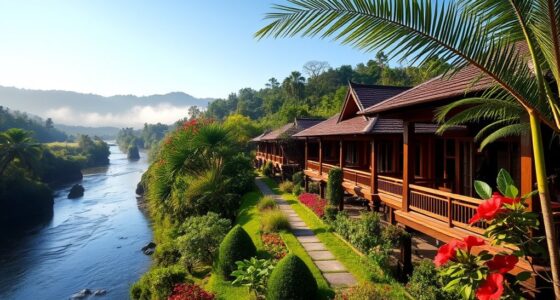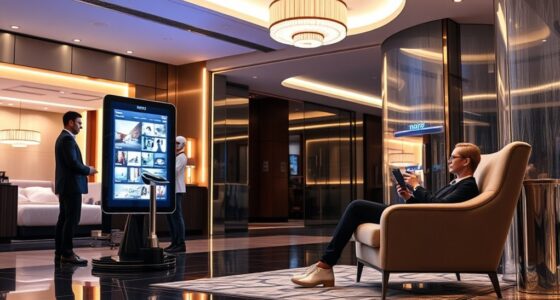Imagine sleeping below the waves in a luxurious underwater hotel with panoramic glass walls that bring marine life right to your bedside. These innovative structures blend stunning architecture, immersive experiences, and eco-friendly designs to offer you unforgettable stays near coral reefs, lagoons, or urban sites. Advanced safety measures and sustainable energy solutions assure comfort and security. Curious how these marvels of engineering create such a unique world beneath the sea? Keep exploring to discover more.
Key Takeaways
- Underwater hotels feature reinforced glass walls and acrylic tunnels for panoramic marine views and immersive experiences.
- Located in prime marine destinations like the Maldives and Dubai, they offer luxury accommodations below the waves.
- Guests can enjoy activities such as snorkeling, scuba diving, and sea-floor walks from their underwater suites.
- Sustainable materials and eco-friendly designs minimize environmental impact and promote marine conservation efforts.
- Advanced safety systems, including airtight seals and emergency protocols, ensure guests sleep safely beneath the ocean.
Innovative Designs and Architectural Marvels
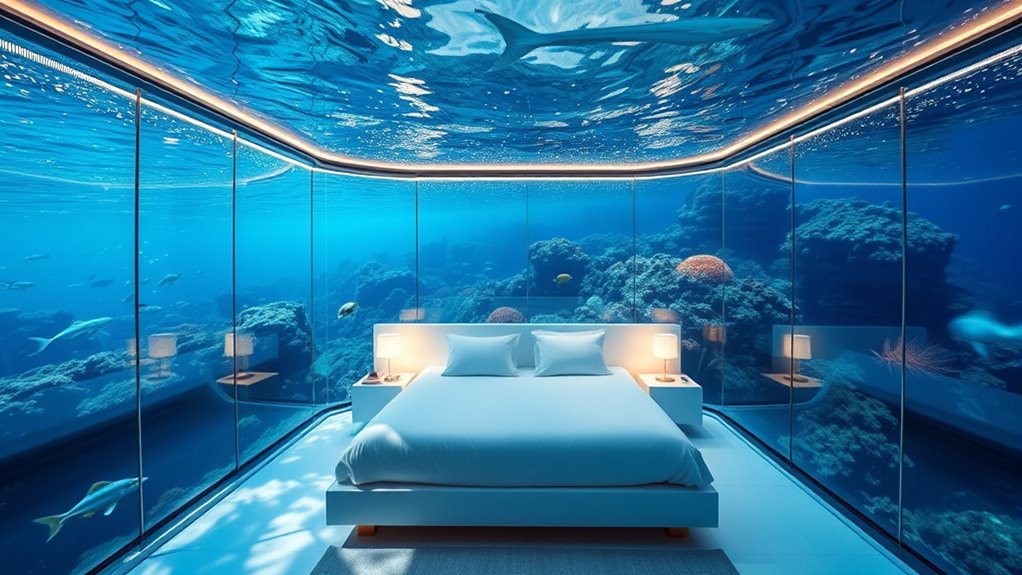
Innovative designs and architectural marvels in underwater hotels showcase how engineering and creativity come together to create extraordinary living spaces beneath the sea. Marine architecture plays a crucial role in shaping these structures, blending functionality with aesthetic appeal. Structural innovation is evident in the use of thick acrylic panels, some up to seven inches, providing panoramic, distortion-free views while withstanding high pressure and corrosive seawater. Exposed concrete and reinforced materials ensure durability against harsh underwater conditions, as seen in structures like Under in Norway. Curved acrylic tunnels and walls enhance immersion, connecting guests visually to marine life. Foundations rely on deep concrete piles for stability, while sustainable materials minimize ecological impact. These designs exemplify how visionary architecture and advanced engineering craft breathtaking underwater habitats. Marine architecture combines technical expertise with artistic vision to push the boundaries of underwater living.
Immersive Guest Experiences Under the Sea

Underwater hotels offer more than just striking architecture; they create immersive experiences that connect guests deeply with the ocean environment. You’ll enjoy panoramic views of marine life like tropical fish and vibrant coral reefs from your bedroom and bathroom windows. Natural light filtering through the water shifts the ambiance, fostering awe and tranquility. You might hear underwater sounds, such as currents and marine calls, enhancing sensory engagement. Activities like guided snorkeling, marine biologist-led talks, and coral planting allow you to participate in ocean conservation efforts firsthand. The hotel’s design features, from underwater showers to private elevators, maximize immersion while maintaining comfort. These experiences deepen your understanding of marine biology and foster a genuine connection to ocean preservation. Incorporating marine conservation initiatives into your stay can further enhance your appreciation and support for ocean ecosystems.
Sustainability and Environmental Conservation Efforts

As you explore underwater hotels, you’ll notice their focus on eco-friendly construction methods that use sustainable materials and minimize environmental impact. These hotels prioritize marine habitat preservation by designing to avoid damaging coral reefs and sensitive ecosystems. Additionally, they implement renewable energy solutions like solar and tidal power to reduce their carbon footprint and support ocean conservation efforts. Many of these establishments also engage in marine conservation initiatives, actively participating in research and protection programs to ensure the long-term health of marine environments. Incorporating renewable energy technologies further enhances their commitment to sustainability by decreasing reliance on fossil fuels and lowering greenhouse gas emissions.
Eco-Friendly Construction Methods
Building eco-friendly underwater hotels involves using sustainable materials and advanced composites that can withstand high pressure and resist corrosion, reducing maintenance and environmental impact. Reinforced concrete, steel alloys, and high-performance composites are selected for durability and minimal ecological disturbance. These materials also support healthy marine flora growth by minimizing chemical leaching. Additionally, designing with underwater acoustics in mind helps reduce noise pollution that could disturb marine life. Modular construction methods, like pre-fabricated components assembled off-site, shorten in-water construction time and lessen seabed disruption. Using eco-conscious materials and efficient design techniques ensures the hotel’s structure remains stable while protecting the surrounding marine environment, creating a sustainable habitat that coexists peacefully with underwater ecosystems. Employing environmentally friendly construction practices further minimizes ecological disruption and promotes marine conservation efforts. Implementing sustainable building techniques can significantly enhance the longevity and ecological harmony of underwater hospitality structures.
Marine Habitat Preservation
Eco-friendly construction methods set the foundation for sustainable underwater hotels, but protecting the surrounding marine environment requires ongoing preservation efforts. You play a crucial role in supporting initiatives that prioritize marine biodiversity and habitat restoration. Many hotels partner with marine conservation organizations to monitor ecosystems, conduct coral reef restoration, and share scientific data. They implement site selection and impact assessments to minimize disturbance, controlling noise and light pollution while managing waste to prevent pollution. Continuous monitoring of coral health and fish populations helps identify threats and maintain habitat integrity. Some hotels install artificial reefs to boost local biodiversity and educate guests about marine conservation. Additionally, incorporating environmental impact assessments ensures that development remains sustainable and eco-friendly. By supporting these efforts, you contribute to safeguarding underwater habitats and ensuring the long-term health of our oceans.
Sustainable Energy Solutions
Sustainable energy solutions are vital for underwater hotels to minimize their environmental impact and operate efficiently in the ocean environment. You can achieve this through renewable integration, combining tidal, wave, and solar power to create reliable energy sources. Tidal turbines harness ocean currents, while wave converters like Pelamis or Oyster generate power from wave motion. Floating solar panels on surface platforms supplement energy needs with solar power. These systems can share excess electricity with nearby communities, promoting regional sustainability. Waste management is equally important—converting plastic waste into biofuel reduces pollution and fossil fuel reliance, while closed-loop systems prevent ocean contamination from human waste. Additionally, goal setting and mindfulness practices can help hotel operators maintain focus on sustainability objectives. By integrating renewable energy and efficient waste management, you guarantee your underwater hotel operates sustainably, preserving marine ecosystems for future generations. Renewable energy integration is a key component of ecological responsibility, ensuring the hotel minimizes its carbon footprint and supports marine conservation efforts.
Global Locations and Development Status

You’ll find underwater hotels mainly in regions like the Maldives, Dubai, and Florida, where development is actively progressing. Some projects, like the Conrad Maldives and Atlantis Dubai, are already operational, while others, such as the Water Discus Hotel, are still under construction. These locations highlight key hotspots driving innovation and growth in underwater hospitality worldwide. Additionally, advances in AI technology are increasingly being utilized to enhance guest experiences and optimize operations in these unique accommodations.
Key Geographic Hotspots
Where are the world’s most notable underwater hotel destinations, and what is their current development status? The Maldives stands out for its historical significance as a pioneer in underwater hospitality, blending luxury with vibrant marine ecosystems influenced by local culture. The Muraka offers a two-level residence, emphasizing exclusivity and immersion. Dubai’s Water Discus Hotel showcases innovative architecture, driven by the city’s reputation as a luxury tourism hub, integrating modern design with cultural influences. China’s InterContinental Shanghai Wonderland uniquely combines underwater and underground elements within its urban setting, highlighting technological innovation. Tanzania’s Manta Resort emphasizes eco-friendly tourism rooted in local island culture, providing a more intimate experience. North America’s Florida project focuses on sustainability, reflecting a global shift toward environmentally conscious underwater hospitality. Additionally, the integration of marine ecosystems into hotel design enhances both guest experience and environmental preservation efforts.
Project Progress and Status
Globally, underwater hotel projects are making steady progress, with several nearing completion or already operational. Market regulations play a vital role in shaping project timelines and costs, often causing delays due to environmental and maritime compliance. Despite these hurdles, investor confidence remains high, driven by booming demand for luxury and eco-tourism experiences, supporting long-term growth. Projects in regions like the U.S., UAE, and Thailand focus on high-end markets, integrating advanced marine engineering and sustainable materials. Technological innovations, such as modular construction and remote monitoring, enhance safety and efficiency. While high capital costs and regulatory complexities limit rapid expansion, ongoing developments indicate a resilient, growing market. These factors guarantee that underwater hotels continue to evolve into safer, more sustainable, and luxurious underwater retreats worldwide. Additionally, the Pimple Patch industry exemplifies how targeted skincare solutions are gaining popularity, highlighting consumer interest in specialized, effective products.
Cutting-Edge Technologies and Safety Measures

Cutting-edge technologies and safety measures in underwater hotels combine advanced engineering with innovative systems to guarantee guest safety and comfort at great depths. You’ll find pressure-resistant materials like corrosion-proof composites and reinforced acrylic windows that withstand water pressures at depths equivalent to 21 stories underwater. Safety features include emergency evacuation mechanisms that allow submerged sections to resurface quickly in crises, ensuring rapid escape. Real-time sensors monitor pressure, water integrity, and environmental conditions, triggering alerts if necessary. You’ll also benefit from airtight seals, soundproofing, and redundant structural systems that enhance safety and comfort. Additional safety measures include escape routes connected to dive centers and specialized fire protection systems tailored for underwater environments. These innovations ensure your stay remains secure, even in the most challenging conditions. Incorporating advanced monitoring systems ensures continuous safety assessments and prompt responses to potential issues.
Unique Amenities and Activities Offered
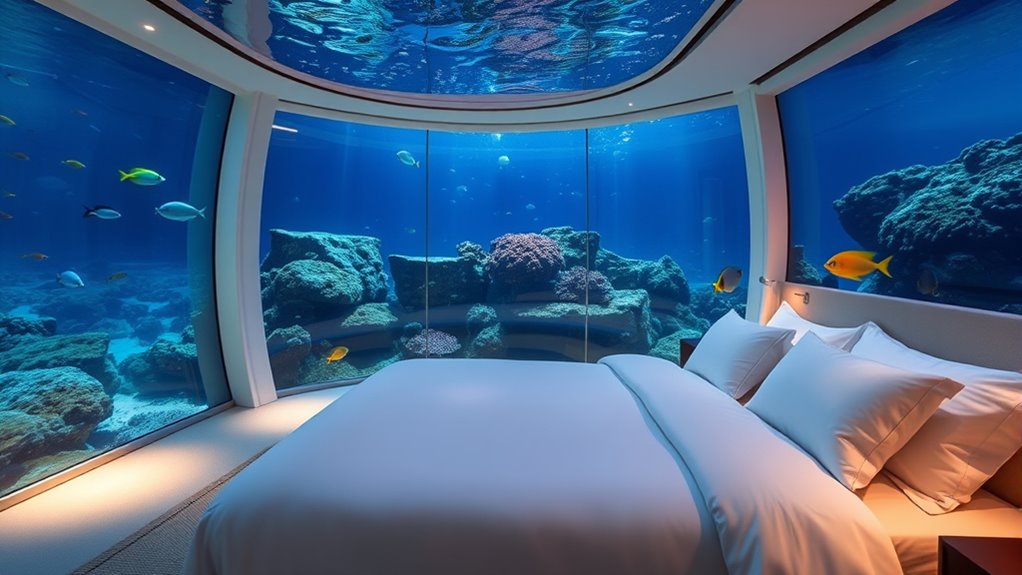
Have you ever wondered what it’s like to wake up surrounded by the ocean’s beauty? In underwater hotels, you can experience marine life up close through large acrylic windows or domes that offer 180-degree panoramic views. Many suites include custom privacy features, like LCD screens that cover transparent walls when you crave solitude. You’ll find luxury furnishings and innovative design that seamlessly blend with the underwater environment. Guests can interact with marine life by controlling underwater lighting or fish feeders, adding an element of underwater art to your stay. Recreational activities include snorkeling, scuba diving, piloting submersibles, and sea-floor walks. Some resorts even offer underwater spa treatments, giving you a calming experience amid vibrant marine life and mesmerizing underwater art. Underwater hotel design incorporates advanced engineering to ensure safety and comfort in the aquatic environment.
Challenges and Future Prospects in Underwater Hospitality
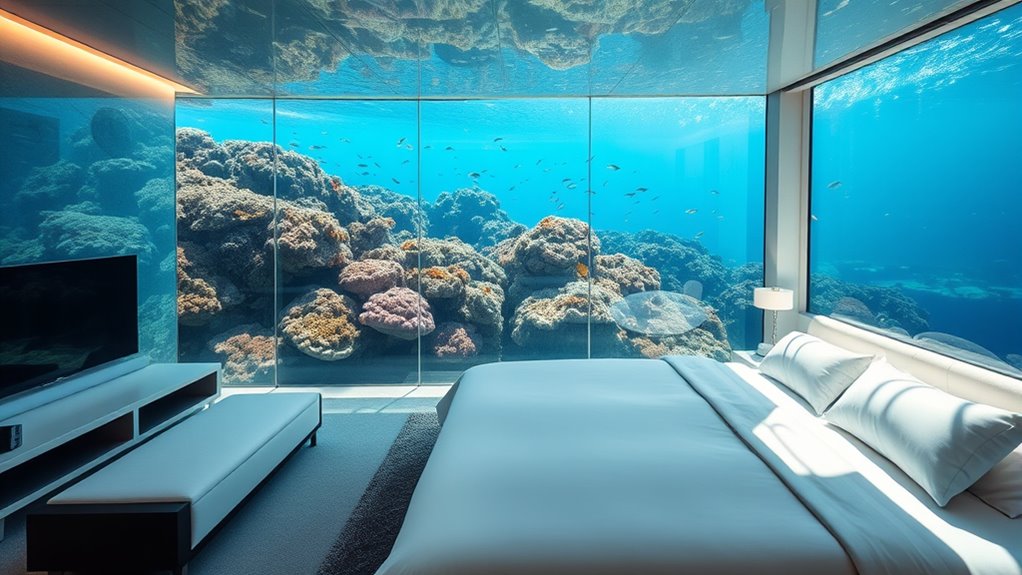
Building underwater hotels presents impressive opportunities but also faces significant technical and environmental hurdles. You must select materials that withstand high water pressure, corrosion, and saltwater effects to guarantee safety and durability. Managing underwater acoustics is crucial to minimize noise pollution that could disturb marine biodiversity. Construction risks include damaging marine ecosystems through dredging and pollution, so eco-friendly practices are essential. High costs for specialized materials, skilled labor, and maintenance pose financial challenges, often limiting locations. Safety is critical; structures need to withstand immense pressure and include emergency protocols for guests. Ongoing maintenance must prevent biofouling and corrosion, ensuring operational safety. Implementing portable and sustainable power sources can help reduce the environmental impact of these structures. To succeed, future projects must balance technological innovation with environmental conservation and market confidence.
Underwater hotels require durable materials, eco-friendly construction, safety protocols, and acoustic management to protect marine life and ensure safety.
- Marine biodiversity preservation
- Underwater acoustics management
- Eco-friendly construction practices
- Cost-effective engineering solutions
- Safety and emergency protocols
How to Experience Underwater Living
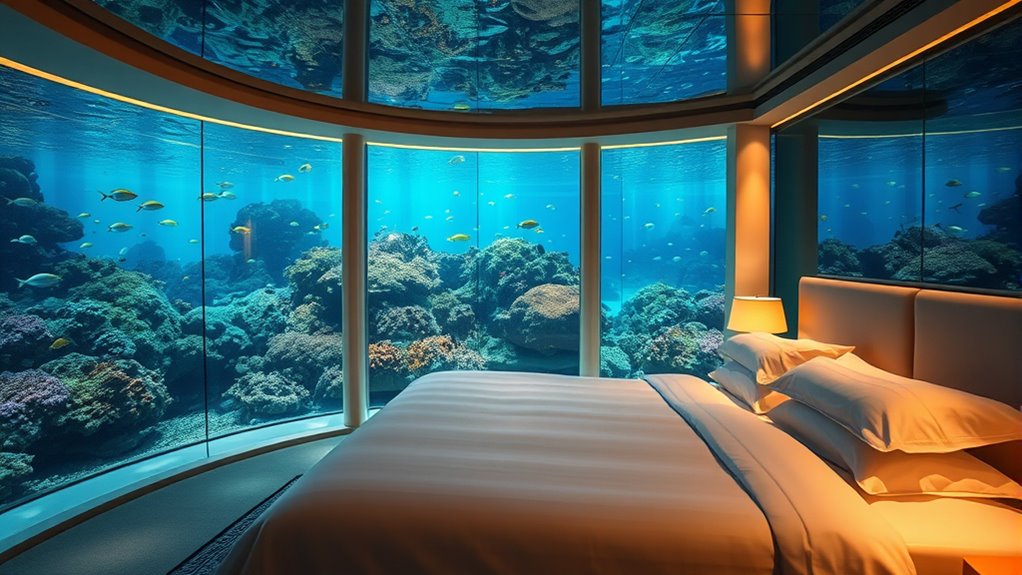
Experiencing underwater living involves careful planning and attention to detail to make the most of your unique stay. Start by booking early, as limited rooms fill quickly, and choose the season based on weather and sea conditions to optimize underwater visibility. Familiarize yourself with accessibility options, like boat transfers or connections to overwater villas. To truly immerse yourself, bring your underwater photography gear to capture marine biology up close—colorful fish, coral reefs, and marine life create stunning images. Prepare for cooler temperatures below the surface and pack waterproof cases for electronics. Review policies on cancellations and included activities such as snorkeling, diving, and spa visits. Additionally, understanding projector technology can enhance your experience by allowing you to enjoy movie nights in your underwater suite with optimal image quality. With proper planning, you’ll enjoy a memorable, immersive experience beneath the waves, observing marine ecosystems and capturing breathtaking underwater scenes.
Frequently Asked Questions
What Are the Costs Involved in Staying at an Underwater Hotel?
When you stay at an underwater hotel, you’ll encounter costs like nightly rates ranging from around USD 900 to over USD 2,000, depending on location and luxury amenities. Extra expenses include exclusive experiences such as guided tours, special meals, and certification packages. You’ll also pay taxes, deposits, and possibly transportation fees. These costs reflect the unique environment and premium services, making your underwater adventure an unforgettable, luxurious experience worth the investment.
How Do Underwater Hotels Handle Emergencies or Evacuations?
In an emergency, your safety hinges on flawless evacuation procedures and rigorous emergency protocols. Underwater hotels are equipped with advanced communication tools, well-trained staff, and detailed evacuation plans, ensuring rapid responses. When disaster strikes, they immediately halt activities, communicate clearly, and evacuate guests swiftly to the surface or safe zones. These measures are designed to handle even the most formidable scenarios, prioritizing your quick, secure exit from below the waves.
Are Underwater Hotel Stays Suitable for Children or Guests With Health Issues?
You should consider child safety and health considerations when choosing an underwater hotel. Some hotels, like Zanzibar’s Underwater Room, are kid-friendly with activities like snorkeling. Others, like Jules’ Undersea Lodge, require scuba diving, making them unsuitable for children. For guests with health issues, hotels like Poseidon offer easier access and controlled air quality. Always check specific hotel amenities and safety measures to guarantee a comfortable, safe stay tailored to your needs.
What Are the Typical Environmental Impacts of Building Underwater Hotels?
Building underwater hotels impacts marine ecosystems through increased marine pollution, such as waste and chemicals, risking water quality. Construction often damages coral reef preservation by destroying habitats and causing sediment displacement, which increases turbidity. You might also disrupt marine life with noise and artificial lighting. To minimize these effects, developers should follow strict regulations, use sustainable materials, and support reef conservation efforts, ensuring the environment remains as healthy as possible.
How Long Can Guests Comfortably Stay Submerged Underwater?
Like drifting through a glass bubble in a vast ocean, you can stay submerged for days, but comfort depends on your body’s harmony with the environment. Your stay is limited by air quality, noise, and the hotel’s underwater design, which buffers marine life encounters and maintains a stable habitat. While some guests enjoy weeklong visits, most find multi-day stays ideal, balancing adventure with safety in this mesmerizing underwater domain.
Conclusion
As you explore underwater hotels, you embrace innovation, immerse yourself in unforgettable experiences, and contribute to sustainability. You witness architectural marvels, enjoy unique amenities, and face challenges with optimism. You discover cutting-edge technology, participate in extraordinary activities, and envision future possibilities. You open your mind to new horizons, embrace evolving designs, and cherish the thrill of sleeping below the waves. In this journey, you not only escape the ordinary but also redefine what it means to stay in style beneath the sea.


